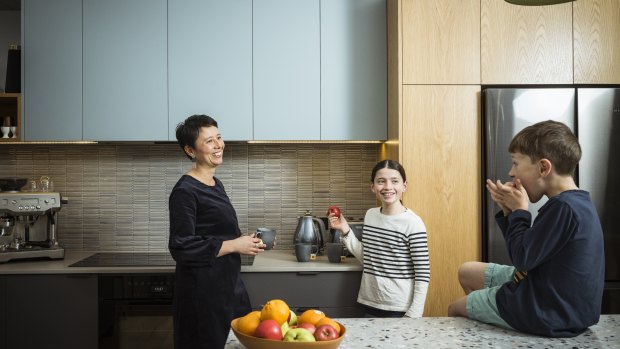By Chloe Booker
As gas prices skyrocket, it might be time to say goodbye to your old gas stovetop and water heater and hello to induction cooktops, heat pumps and hydronic heaters.
A cold snap on the east coast, Russian sanctions and outages at ageing coal-fired power-stations have created what the industry has dubbed the “biggest energy crisis in 50 years”.

Sherrin Yeo and her children Isabelle and Elliot spend time in their electric-powered kitchen.Credit: Chris Hopkins
Victoria is the state most vulnerable to the resulting price hikes, with 3 million gas connections and 65 per cent of the nation’s total residential use.
The Andrews government is looking at implementing a proposal to halve gas use by the end of the decade and switch households to electric appliances which can more easily be powered by renewable energy sources.
And if price and the environment isn’t enough of a motivator, research by the Climate Council released last month found gas cooking can have the same impact as passive smoking on children with asthma.
So, how do you make the switch?
Sherrin Yeo, who converted her Ascot Vale home from gas to electric last year, said the first step of researching options was not entirely straightforward.
“I spent hours and hours Googling,” the renewable energy engineer said. “There’s a real lack of information out there.”
Suppliers often couldn’t tell her how much energy each appliance used, and also tried to convince her to stay with gas, she said.
Energy consultant Tim Forcey said finding suppliers and tradespeople who were on the same page as customers could help make the transition smoother.
Budget-strapped consumers could access his Facebook group, My Efficient Electric Home, he said, where more than 60,000 members help answer each other’s questions and pass on recommendations.
Forcey said Sanctuary Magazine, not-for-profit Australian Energy Foundation, Renew Magazine and Choice were also great resources.
The next step is to chose your appliances and here Energy Consumers Australia chief executive Lynne Gallagher said most people would be better off replacing their appliances one at a time as they reached the end of their life.
“Electricity prices are also rising, appliances have long lives and the time taken to recoup such investment will be long,” she said.
However, Gallagher said stronger incentives were needed to ensure consumers didn’t purchase new gas appliances that lasted up to 20 years.
Yeo took the opportunity to make the transition all at once when she renovated her house.
“There’s going to be an acceleration away from gas, so it just seemed totally crazy to install any gas appliances,” she said.
Yeo estimated she spent more than $50,000 switching her appliances all at once in the home she shares with her partner and their two children.
This included installing an induction cooktop, an electric heat pump to warm their hot water and wall-mounted hydronic heaters.
Hydronic heating works by circulating electrically heated water through the home via pipes which can also run under the floor.
Electric heat pumps for hot water can be complicated to install, but the state government is offering a 50 per cent rebate of up to $1000 on eligible heat pump hot water systems.
Top of the range induction cooktops can cost more than $10,000.
Forcey said people without that kind of money, or those who live in apartments with shared utilities, could cover their existing cooktop and put a portable induction cooktop on top. These can be purchases for $50 from Aldi or $80 from Ikea.
The next challenge is learning how to use it.
Renowned chef Neil Perry said the “now you are cooking with gas” thinking was outdated. “You’ve got heaps more control with induction than you do with gas,” he said. “People freak out because they can’t see [a flame], but the reality is, you very quickly learn.”
Consumers might also need to purchase new pots and pans that are compatible with your new cooktop.
However, Forcey, a former University of Melbourne researcher, said people could slash a third off their heating bill.
“The easiest way for a lot of people to stop using a heck of a lot of gas and start saving a lot of money is to just find the heat button on their reverse cycle air conditioner,” he said.
Spilt system air-conditioners could be purchased for as little as $1000, after applying the state government’s $1000 rebate.
However, upgrading your heating will have little effect unless you adequately insulate your home. Forcey said many Victorians homes had numerous vents that were required for safety when gas heating was used.
When you have finally swapped out all of your gas appliances, it’s time to call your energy supplier to ask them to cut off your gas.
This is to avoid paying the $270 a year supply charge that’s applied regardless of whether you use it.
The Morning Edition newsletter is our guide to the day’s most important and interesting stories, analysis and insights. Sign up here.